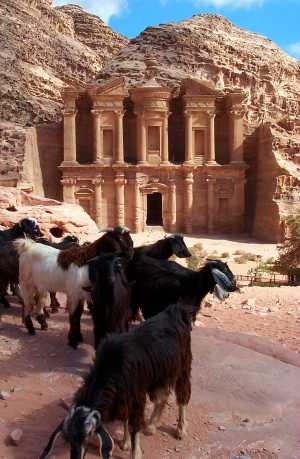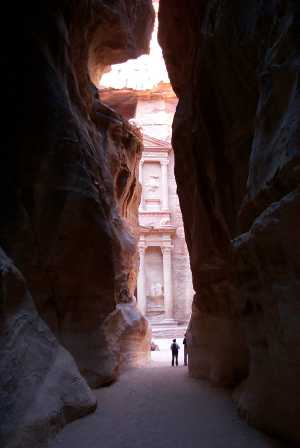Daily Devotion for July 1, 206
(click on the photo below for a LARGER view)
 So perfectly concealed among the rose-red cliffs of Edom, this amazingly well preserved city of Petra remained lost and almost forgotten for over a thousand years. Nestled in a craggy canyon of red, pink, white, brown and violet rock, the city is practically invisible from the air and impregnable from the ground. The natural caves that honeycomb the area were home to man thousands of years before history began.
So perfectly concealed among the rose-red cliffs of Edom, this amazingly well preserved city of Petra remained lost and almost forgotten for over a thousand years. Nestled in a craggy canyon of red, pink, white, brown and violet rock, the city is practically invisible from the air and impregnable from the ground. The natural caves that honeycomb the area were home to man thousands of years before history began. "The Treasury," the first facade you see as you enter Petra, is world famous because of the Indiana Jones "The Last Crusade" movie. Carved into the cliff, "The Treasury" is so-named because at the top of the enormous structure is a carved, stone object that looks like an urn. According to legend, the urn contains treasure. Chips on the inaccessible urn are the results of unsuccessful attempts to break it with bullets and stones.
"The Treasury," the first facade you see as you enter Petra, is world famous because of the Indiana Jones "The Last Crusade" movie. Carved into the cliff, "The Treasury" is so-named because at the top of the enormous structure is a carved, stone object that looks like an urn. According to legend, the urn contains treasure. Chips on the inaccessible urn are the results of unsuccessful attempts to break it with bullets and stones.Heavenly Father – one can think that we can build something somewhere and be secure from all outside forces; we can hide in the rocks. But help me always to remember that security can only be found in the true ROCK, your son Jesus Christ. Amen
HISTORY OF PETRA
7,000 BCE: The first settlement here is believed to date back to this time.
4th century BCE: Petra becomes the capital of the Nabateans.
312: Attacked by Antigonus, who killed many of the women and children, while all men were absent.
106 CE: Conquered by the Romans. The Romans start constructing their form of city, with colonnaded streets, baths and theatres. Petra was included into the Roman province of Arabian Patraea.
2nd century: Petra has economic progress.
4th century: The rise of Palmyra results in a quick decline of Petra's importance, as there is no trade left.
7th century: Arab occupation, but by now Petra is only a small town.
12th century: Captured by the crusaders, who settled here and altered many of the buildings.
1812: Petra is "rediscovered" by the Swiss Johann Louis Burckhardt who experienced an understandable unwillingness of the local Bedouins to have foreigners intrude into their areas.
Did someone send you this Devotion? Would you like to receive future ones directly? Click here to subscribe.
While in the Middle East for a Biblical Study Journey with fellow Word Among Us Students, a 5-person crew is filming and taking pictures of the various sites. This vibrant photographic material will be incorporated into next year's Word Among Us classes.
Want to learn more about the Bible Jesus used – The Old Testament – and the Bible Jesus taught? Enroll today in Word Among Us – Cover to Cover study of the Bible starting in Genesis and going through Revelation including the inter - testamental period, using history and archeology and Biblical culture to make the text alive - taught by Tim Hetzner.
Class sites are across the USA. Click here for more information.
| Tim Hetzner - President - Lutheran Church Charities | ||
 | 333 W. Lake Street, Addison, Illinois 60101 | |
| (866) 455-6466 • Fax: (866) 451-1476 | ||
| Web Site: lcc.LutheranChurchCharities.org | ||
| E-Mail: TimHetzner@LutheranChurchCharities.org | ||
| At the end of the day. . . Making A Difference | ||

0 Comments:
Post a Comment
<< Home